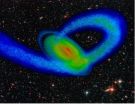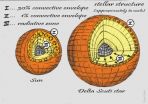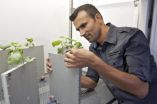(Press-News.org) PITTSBURGH—The signature spiral arms of the Milky Way galaxy were likely formed by an epic collision between the Milky Way and the Sagittarius Dwarf galaxy, according to a University of Pittsburgh researcher and his collaborators, published today in the prestigious British journal Nature.
Supercomputer simulations by Christopher W. Purcell, postdoctoral research associate in the Department of Physics and Astronomy in Pitt's School of Arts and Sciences, and colleagues report their findings in a paper titled "The Sagittarius Impact as an Architect of Spirality and Outer Rings in the Milky Way."
This paper is the first to identify Sagittarius as the architect of spiral structure in our Milky Way. "It presents a new and somewhat unexpected way of thinking about why the galaxy we live in looks the way it does," says Purcell.
"Cosmologically speaking, it demonstrates the idea that relatively small impacts like this can have a dramatic impact on the structure of galaxies throughout the universe," he adds. This idea had been assumed theoretically, but never demonstrated.
Purcell's collaborators include University of California High-Performance AstroComputing Center (UC-HIPACC)-affiliates James S. Bullock, Erik J. Tollerud, and Miguel Rocha, all at the University of California at Irvine. The fifth coauthor is Sukanya Chakrabarti at Florida Atlantic University.
In the field of cosmology, supercomputer simulations are the only laboratories for scientific experimentation. With supercomputers, astronomers can recreate a small-scale simulation or model of distant, violent events that occurred over billions of years, and observe that model in sped-up time, in order to make predictions that can be tested by actual observations of the universe.
Purcell's findings are based on supercomputer simulations he conducted for his PhD at the University of California, Irvine, and in the lab of Pitt professor of physics and astronomy Andrew Zentner.
Interestingly, Purcell's simulations revealed that even more important than the stars of the Sagittarius Dwarf was its halo of invisible "dark matter"—equal in mass to all the stars in the Milky Way.
Visible matter makes up less than five percent of the universe, while nearly a quarter of the universe is made of transparent dark matter. Its existence is felt only through its gravitational influence. It is now known that every galaxy, including the Sagittarius Dwarf (precollision) and our own Milky Way, resides at the center of a giant halo of dark matter several times larger in radius and many times greater in mass.
"When all the dark matter smacked into the Milky Way, 80 to 90 percent of it was stripped off," Purcell says. That first impact—more than two billion years ago—produced instabilities that were quickly amplified, eventually forming the spiral arms and ring structures in the outskirts of our own galaxy.
In his dissertation, Purcell focused on the question: What effects have the repeated collisions with the Sagittarius Dwarf had on the Milky Way?
Throughout the past few decades, conventional wisdom has been that the Milky Way was relatively unperturbed for the past several million years. Whatever spiral structure exists, these arms, were just a result of the Milky Way disc evolving in isolation.
Since the Sagittarius Dwarf was discovered, astronomers have tried to match up debris from that galaxy to what they saw in the universe. In 2003, infrared telescopes and supercomputers that traced the orbital motions of its stars has revealed that the Sagittarius Dwarf had actually collided with the Milky Way twice—once 1.9 billion years ago and again 0.9 billion years ago.
"But what those collisions did to the Milky Way hadn't been simulated at all," says Purcell. "Ours was the first ever to try to do that."
Researchers found that the collision set up instabilities—fluctuations in density of stars—in the flat disk of the rotating Milky Way. Our galaxy rotates faster toward its center than toward its edges, so those instabilities were stretched and sheared, leading to the formation of spiral arms.
The simulations also revealed that the impact gave rise to ring-like structures found at the edges of our galaxy.
The second impact affected the Milky Way less, giving rise to only milder, less dense spiral-creating waves, because the Sagittarius Dwarf had by then lost most of its dark matter mass.
Without the dark matter to hold the dwarf galaxy together, its visible stars began to be pulled apart by the Milky Way's huge gravitational field and tidal forces.
"The dominant cosmology in astrophysics is one that's very violent on small scales. Galaxies like the Milky Way are constantly being bombarded by these small dwarf galaxies. It had not been appreciated prior to our work just how dramatic those impacts could be on the stellar disc itself," says Purcell. "We expected to find some more subtle signatures of an impact like this—a flare in the outer disc, like bell-bottom jeans. We expected to see some mild morphological changes to the Milky Way. But we did not expect to see a spiral structure begin to emerge as a result of these impacts. That was something we didn't foresee."
Indeed, Purcell and collaborators delayed publication for several months while they made sure they understood why they were seeing these results. "We had to convince ourselves that we weren't crazy," he jokes.
Today, long streamers of stars from the dismembered dwarf galaxy arch over and around the Milky Way, and "right now, billions and billions of dark matter particles from the Sagittarius Dwarf are raining down onto the Earth," said Purcell. "Meantime, the Sun itself is revolving around the center of the Milky Way Galaxy, in a complex and still-evolving system of multiple spiral arms."
We're just a few million years short of a third impact, Purcell says. But how can the researchers tell?
"We can tell when we look toward the center of the Milky Way," says Purcell. "Immediately on the opposite side of us, we can see this blob of stars crashing into the southern face of the disc from beneath. We can measure the velocities of these stars. We know that the dwarf galaxy is just about to smash the disc—in only another 10 million years."
INFORMATION:
The University of California High-Performance AstroComputing Center (UC-HIPACC), based at the University of California at Santa Cruz, is a consortium of all the University of California campuses, three Department of Energy laboratories (Lawrence Berkeley Laboratory, Lawrence Livermore Laboratory, and Los Alamos National Laboratory), and NASA Ames Research Center.
How the Milky Way got its spiral
Pitt researcher's supercomputer simulation uncovers how a collision with a dwarf galaxy triggered the formation of the Milky Way's spiral arms
2011-09-16
ELSE PRESS RELEASES FROM THIS DATE:
Los Angeles Dentist Achieves Exceptional Level of Invisalign Case Experience
2011-09-16
Dr. Shervin Louie, best Los Angeles dentist, has earned the status of Invisalign premier provider. This certificate is only awarded to those dental professionals who have achieved an exceptional level of Invisalign case experience.
Invisalign Preferred Providers have achieved a level of clinical training and experience in treating patients with the Invisalign system. Dentists must maintain regular treatment submission and complete ongoing training classes in order to earn the designation as a Preferred Provider of Invisalign.
"I am honored to be name an Invisalign ...
Restoring forests and planting trees on farms can greatly improve food security
2011-09-16
NAIROBI, KENYA (12 SEPTEMBER 2011) – Restoring and preserving dryland forests and planting more trees to provide food, fodder and fertilizer on small farms are critical steps toward preventing the recurrence of the famine now threatening millions of people in the Horn of Africa, according to forestry experts from the CGIAR Consortium.
Across the Horn, drought-induced famine has claimed tens of thousands of lives and swelled refugee camps in Kenya, Ethiopia and elsewhere, with millions of starving people – many of them children. Bearing the brunt of the crisis is Somalia, ...
The turbulent lives of stars
2011-09-16
This press release is available in German.
The stars are boiling! The reason is the energy generated in the center of the star that wants to escape. If this does not happen quickly enough, the star starts to 'boil' in the outer layers causing vibrations that result in light variations, like in the Sun. Such oscillations have now been discovered by Victoria Antoci and collaborators using the NASA spacecraft Kepler, but in a much hotter star. The scientists publish this in the most recent issue of Nature.
Besides the discovery of earth-like planets, astronomy is concerned ...
Serotonin levels affect the brain's response to anger
2011-09-16
Fluctuations of serotonin levels in the brain, which often occur when someone hasn't eaten or is stressed, affects brain regions that enable people to regulate anger, new research from the University of Cambridge has shown.
Although reduced serotonin levels have previously been implicated in aggression, this is the first study which has shown how this chemical helps regulate behaviour in the brain as well as why some individuals may be more prone to aggression. The research findings were published today, 15 September, in the journal Biological Psychiatry.
For the study, ...
Two-thirds of hepatitis C patients can see a cure in half the time, new study finds
2011-09-16
LOS ANGELES (Sept. 15, 2011) – Treatment with a telaprevir-based combination regimen for hepatitis C – heretofore a chronic, destructive and difficult to manage disease – effectively can be shortened to six months in about two-thirds of patients, finds a new study published Thursday in the New England Journal of Medicine.
Telaprevir, a drug approved for use against hepatitis C in May, inhibits replication of virus. This anti-viral drug and a similar medication called boceprevir have nearly doubled the number of patients with sustained response. Among patients treated ...
Sabal Financial Group, L.P. Announces the Acquisition of $158 Million Loan Portfolio through FDIC's Small Investor Program
2011-09-16
Sabal Financial Group, L.P., formerly Milestone Asset Resolution Company, LLC, a diversified financial services management firm, announces the recent acquisition of a $158 million portfolio of performing and non-performing commercial real estate loans and commercial acquisition, development and construction loans and credit facilities. The acquisition represents the first sale transaction under the FDIC's pilot Small Investor Program ("SIP") and represents the commercial loan component of a larger $297 million loan sale mandated by the FDIC for the assets of failed ...
Small group homes are better for many dementia patients and their families
2011-09-16
Small group homes for people with dementia provide good quality care and a domestic environment where people can live as individuals and families can get involved. But tension can arise when it comes to deciding who takes responsibilities for certain practical and caring tasks.
Those are the key findings of a study of two group living care homes in the Netherlands, published in the September issue of the Journal of Clinical Nursing.
"It's estimated that 80 million people worldwide will suffer from dementia by 2040" says Ezra van Zadelhoff from Maastricht University. ...
All credit ratings not created equal
2011-09-16
At least one of the "Big Three" credit ratings agencies exaggerated credit scores of private debt compared to public bonds during the last 30 years, according to a new study by researchers from Rice University, American University and Indiana University.
The recent downgrade of U.S. debt by Standard & Poor's makes the study timely, and the research adds to the current debate surrounding regulatory reliance on credit ratings and the current Securities and Exchange Commission proposal to standardize credit ratings across asset classes.
For the study, "Credit Ratings ...
Plants create a water reserve in the soil
2011-09-16
It has long been known that roots alter the soil in their immediate vicinity, where other microorganisms live and the chemical composition is altered compared to that further away from the roots. An international research team has now demonstrated in experiments at the Paul Scherrer Institute that the soil in the vicinity of roots also contains more water – contrary to the earlier belief that there must be less water in this region, as the plant takes up water from the soil. Apparently, however, plants create a small water reserve that helps to tide them over through short ...
Stents may reduce heart attacks by delivering downstream medication
2011-09-16
Tuesday, September 13, 2011, Cleveland: Researchers at Cleveland Clinic have discovered that cardiac patients receiving medicated stents – a procedure that occurs often when blood vessels are blocked – have a lower likelihood of suffering heart attacks or developing new blockages in the vessel downstream from the stent.
Stents have been used to prevent re-narrowing of coronary arteries after balloon angioplasty and newer designs have included coatings with medications to prevent re-narrowing from occurring within the stent after implantation. The recent study – led by ...
LAST 30 PRESS RELEASES:
Duke and Duke-NUS’ joint cross-population research to uncover "East-West" differences in disease and care
Scientists to ‘spy’ on cancer- immune cell interactions using quantum technology breakthrough
Tech savvy users have most digital concerns
Making lighter work of calculating fluid and heat flow
Normalizing blood sugar can halve heart attack risk
Lowering blood sugar cuts heart attack risk in people with prediabetes
Study links genetic variants to risk of blinding eye disease in premature infants
Non-opioid ‘pain sponge’ therapy halts cartilage degeneration and relieves chronic pain
AI can pick up cultural values by mimicking how kids learn
China’s ecological redlines offer fast track to 30 x 30 global conservation goal
Invisible indoor threats: emerging household contaminants and their growing risks to human health
Adding antibody treatment to chemo boosts outcomes for children with rare cancer
Germline pathogenic variants among women without a history of breast cancer
Tanning beds triple melanoma risk, potentially causing broad DNA damage
Unique bond identified as key to viral infection speed
Indoor tanning makes youthful skin much older on a genetic level
Mouse model sheds new light on the causes and potential solutions to human GI problems linked to muscular dystrophy
The Journal of Nuclear Medicine ahead-of-print tip sheet: December 12, 2025
Smarter tools for peering into the microscopic world
Applications open for funding to conduct research in the Kinsey Institute archives
Global measure underestimates the severity of food insecurity
Child survivors of critical illness are missing out on timely follow up care
Risk-based vs annual breast cancer screening / the WISDOM randomized clinical trial
University of Toronto launches Electric Vehicle Innovation Ontario to accelerate advanced EV technologies and build Canada’s innovation advantage
Early relapse predicts poor outcomes in aggressive blood cancer
American College of Lifestyle Medicine applauds two CMS models aligned with lifestyle medicine practice and reimbursement
Clinical trial finds cannabis use not a barrier to quitting nicotine vaping
Supplemental nutrition assistance program policies and food insecurity
Switching immune cells to “night mode” could limit damage after a heart attack, study suggests
URI-based Global RIghts Project report spotlights continued troubling trends in worldwide inhumane treatment
[Press-News.org] How the Milky Way got its spiralPitt researcher's supercomputer simulation uncovers how a collision with a dwarf galaxy triggered the formation of the Milky Way's spiral arms


